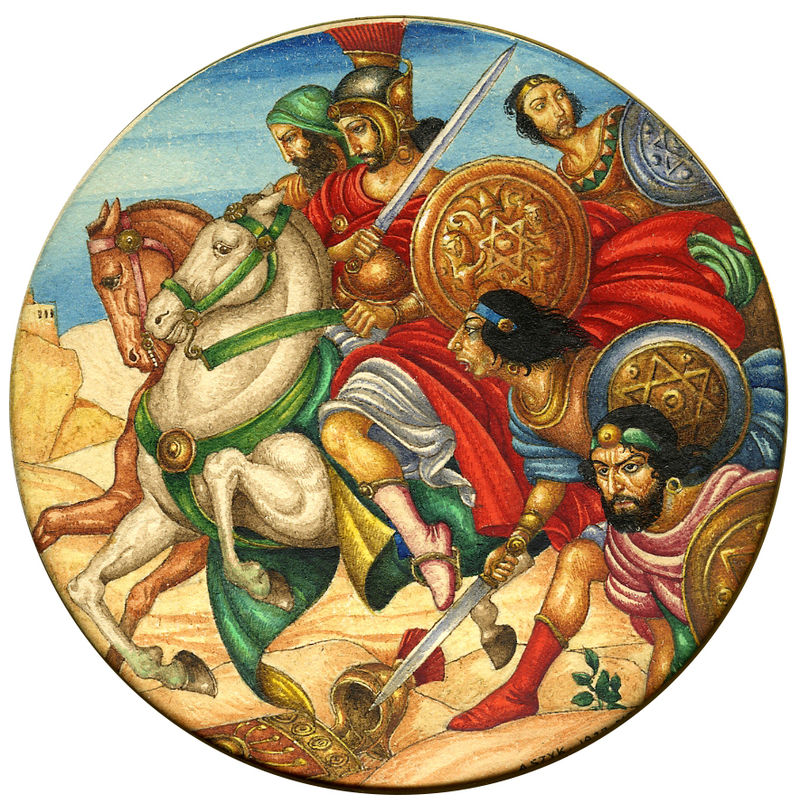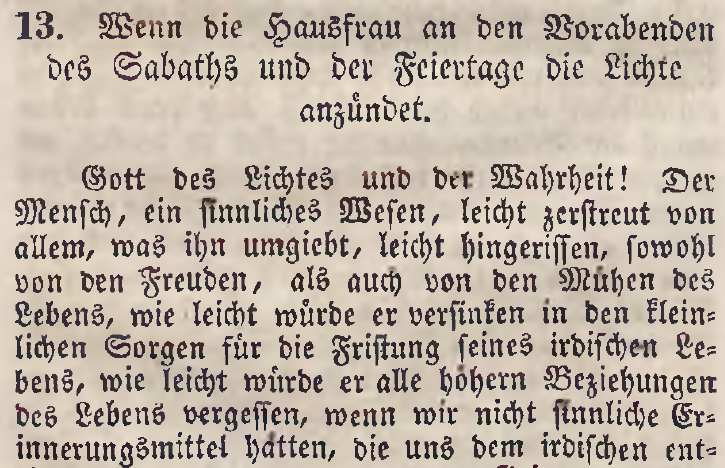| Contribute a translation | Source (English) |
|---|---|
Lighting of Lamps: Lights in the Temple | |
“And Aaron shall burn thereon sweet incense every morning; when he dresseth the lamps he shall burn incense upon it. And when Aaron lighteth the lamps at even, he shall burn incense upon it; a perpetual incense before the Lord, throughout your generations.” (Exodus 30:7-8) | |
Now the stars are lit in heaven, We must light our lamps on earth; Every star a signal given From the God of our new birth: Every lamp an answer faint, Like the prayer of mortal Saint. | |
Mark the hour and turn this way, Sons of Israel, far and near! Wearied with the world’s dim day, Turn to Him whose eyes are here, Open, watching day and night, Beaming unapproached light! | |
With sweet oil-drops in His hour Feed the branch of many lights, Token of protecting power, Pledg’d to faithful Israelites, Emblem of the anointed Home, When the glory deigns to come. | |
Watchers of the sacred flame, Sons of Aaron! serve in fear,— Deadly is th’ avenger’s aim, Should th’ unhallowed enter here; Keen his fires, should recreants dare Breathe the pure and fragrant air | |
There is One will bless your toil— He who comes in Heaven’s attire, Morn by morn, with holy oil; Eve by eve, with holy fire! Pray!—your prayer will be allowed, Mingling with His incense cloud! |
“Lights in the Temple” by Rev. John Keble (1792-1866) was initially published anonymously as the first of five poems under the title “Lighting of Lamps” in The British Magazine and Monthly Register of Religious and Ecclesiastical Information (1 March 1834, vol. 5, p. 280). A few years later it was republished under a pseudonym ‘γ’ in a collection of religious poetry, Lyrica Apostolica (1836) (titled “Lights in the Temple” in the Table of Contents under the section “Lighting of Lamps,” pp. 74-75). Keble’s authorship was clearly identified in Miscellaneous Poems, published posthumously in 1868. The poem was one of three by Keble included in the Standard Book of Jewish Verse (ed. Joseph Friedlander and George Alexander Kohut, 1917), pp. 72-73.
Keble, his poetry, and the initial publications it appeared in were strongly associated with the Oxford Movement, a movement of high church members of the Church of England which began in the 1830s and eventually developed into Anglo-Catholicism. In the sermon, “Jewish Zeal, a Pattern for Christians,” John Henry Newman (1801-1890), argued that Christians should emulate the religious fervor of ancient Israel and criticized the view that “the Jews were almost barbarians”[1] J. H. Newman, Parochial and Plain Sermons (3:176-177) as quoted by Mikhail Stetckevich in “The Old Testament and Judaism in the Last Anglican Sermons of John Henry Newman” Hebrew Studies, 2016, Vol. 57 (2016), pp. 204. Mikhail Stetckevich, writing on the Oxford Movement notes however, “Newman never abandoned supersessionism; in addition, he was a theologian rather than a historian of religion. His interest in Jews was entirely a function of their connection to Christianity; for that reason, Hellenistic Judaism attracted his attention to a much lesser degree than did the beliefs and practices of the biblical period, and he sharply criticized the Pharisees. Newman’s attitude to Judaism after Jesus was profoundly negative; a graphic example of this attitude is in his book Arians of the Fourth Century where he argues that this heresy had Judaic roots.”[2] ibid. p. 205. Find J. H. Newman, Lectures on Justification (London: J. G. and F. Rivington, 1838, p. 372).
Whether this context was of very much concern to Friedlander and Kohut is an open question. In their Standard Book of Jewish Verse, they include a number of poems by Christian authors that either romanticize biblical Israel or, in contrast, present a picture of the Jew in the Diaspora in some lachrymose and dismal way. In their Introduction, Friedlander writes,
Poetry may be said at least to have been the ground on which Jew and Gentile could make their common humanity felt, and it is not the least satisfaction to the compiler of this Anthology that here they stand side by side in a great cause, with one aim before them and united in its performance as never before. The history of Jewish Emancipation and the gradual dispulsion of prejudice and injustice may very well be traced through Byron and Lessing and Browning and Swinburne and many others, to these days of liberty and enlightenment, blazing the onward march of civilization through centuries of dark superstition and intolerance, teaching lessons of the highest import to the world of true brotherhood, wise reconciliation of different beliefs and a higher philosophy of life and conduct.
In these, most conspicuous are the poems of non-Jewish poets, who have eagerly employed their gifts to crush down prejudice and oppression. Byron and Lessing were the first in this army of equally distinguished sons of the Muse: Longfellow, Browning, Joaquin Miller, Wordsworth, Townsend and many others. The most eloquent diatribes on the Dreyfus Case were written by Swinburne, and the Russian pogroms called forth a great number of stirring poems by Christian writers…
The Jews of modern times have never done justice to the great service rendered them by Byron, and it would only be fitting that a monument be raised in England to that great poet, commemorating his glorious aid in vindicating for the Jews their rightful place among the nations of the world. So, too, Lessing, in his drama “Nathan the Wise,” and through his friendship with Moses Mendelssohn, brought about a powerful reaction in favor of the Jew. To these two gifted men, must be attributed the impetus that was given to both Jewish and non-Jewish poets to find in the Jew a fit subject for poetical illustration. Most of the distinguished poets of the past and present generation have added to the rich store of poetic lore some sterling work of Jewish interest. These comprise our greatest poets, among them Wordsworth, Browning, Scott, Longfellow, Tennyson, Swinburne, George Eliot, Thomas Bailey Aldrich and others too numerous to mention, but who should be remembered with honor and gratitude.
But beyond the immediate Jewish audience for the Standard Book of Jewish Verse, I imagine that Friedlander and Kohut thoughtfully considered their work speaking to a literate non-Jewish public. After the pogroms of the early 1880s and the activity of the early Zionist movement, the choice of such works in the Standard Book might have been intended to reach a non-Jewish and Christian audience familiar with these authors, and to engage their sympathy in the urgency of a Jewish national and cultural revival. –Aharon Varady
Source(s)


Notes
| 1 | J. H. Newman, Parochial and Plain Sermons (3:176-177) as quoted by Mikhail Stetckevich in “The Old Testament and Judaism in the Last Anglican Sermons of John Henry Newman” Hebrew Studies, 2016, Vol. 57 (2016), pp. 204. |
|---|---|
| 2 | ibid. p. 205. Find J. H. Newman, Lectures on Justification (London: J. G. and F. Rivington, 1838, p. 372). |

“Lights in the Temple, a poem by John Keble (1834)” is shared through the Open Siddur Project with a Creative Commons Attribution-ShareAlike 4.0 International copyleft license.










Leave a Reply